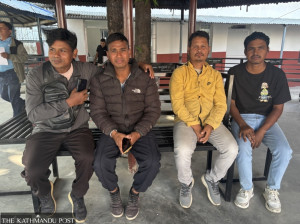Koshi Province
Hatiyas keep Biratnagar’s farmers and consumers connected
The age-old market tradition of Madhesh helps sustain livelihoods and the local economy.
Parbat Portel
Every day, the streets, intersections, and open grounds of Biratnagar come alive with hatiyas—traditional weekly markets that remain deeply embedded in the socio-economic and cultural fabric of the Tarai. Far more than just open markets, these gatherings are vital bridges between local farmers and urban consumers, bypassing middlemen and preserving an age-old way of life.
From dawn, farmers arrive at hatiyas on ox-carts, bicycles, rickshaws, or simply carrying goods on their shoulders. They spread out their fresh produce such as organic vegetables and fruits and other products like rice, wheat flour, lentils, eggs and milk.
“The hatiya is not just about trade, it is an essential part of our social and cultural life,” said Parul Chhetri, a longtime resident of Biratnagar. “It directly connects villages to the city and keeps the entire metropolis vibrant.”
In a commercial world increasingly dominated by intermediaries, hatiyas offer a refreshing alternative. Producers and consumers meet face-to-face, negotiating prices and building trust. This direct connection not only ensures that farmers receive fair prices but also enables consumers to purchase fresh goods at lower prices.
“Hatiyas have removed profit-hungry middlemen out of the picture,” said Ram Kumar Mandal, who has been selling products at the market for years. “That’s why these hatiyas are popular.”
Hatiya is not only a platform for buying and selling agricultural products. It is also a powerful engine for the local economy. Hundreds of farmers sell their goods daily to thousands of consumers who throng the stalls.
Although there is no official tally of daily transactions, the Biratnagar Metropolitan City estimates that trade worth millions of rupees takes place each week. “We estimate daily transactions at a few hundred thousands. This year, we’re initiating a comprehensive study of the hatiya economy,” said Saroj Timsina, chief of the municipal revenue unit.
Hatiyas generate employment as well. They sustain informal labourers, local transport operators, small-scale traders and women entrepreneurs. “It’s a centre not just for trade but also for social interaction,” said Dinesh Shrestha, another local resident. “People talk, exchange news, and build relationships.”
The crowd includes elders and youth, women and children—all contributing to the hatiya’s vibrant atmosphere. “The hatiya is our way of life,” said Man Kumari Sardar from Budhiganga Rural Municipality who has been attending hatiyas for 30 years.
The hatiya tradition has its drawbacks as well. Traffic congestion and waste management are pressing concerns. Plastic use remains widespread and proper sanitation is often lacking.
“Waste collection is the responsibility of the contractor. They must clean up immediately after the market wraps up. We’ve tried to ensure that waste isn’t left unmanaged,” said Punam Kumar Dahal, chief at the sanitation unit of the metropolis.
Bedraj Acharya, a Biratnagar-based economist, emphasises the importance of hatiya. “Hatiya represents a no-middleman market model. It benefits both—farmers sell their produce fresh and direct, and consumers get affordable, organic food. It's an ideal local economic system,” he says.
Unlike traditional weekly markets, Biratnagar’s hatiyas operate daily in different neighbourhoods, ensuring wide access. On Sundays, markets pop up in Rajbanshi Chowk (ward 4), Jamunagachhi (ward 5) and Kochakhaal (ward 6). Mondays see transactions at Sombare Haat (ward 2), Shivamarga (ward 10) and Jhameli Chowk (border of wards 13 and 16). Tuesdays bring trade to Paropakar Ghat (ward 1), Trimurti Chowk (ward 5) and Degree Campus area (ward 14). The cycle continues through the week, with Saturdays hosting markets in Trimurti Chowk and near the Koshi Project.
This rotation ensures every neighbourhood gets a fair share of fresh supplies and sustains their cash flow. Small traders, vegetable vendors, drivers, porters, and women all benefit. The markets support a wide informal economy that’s often invisible in formal statistics but is essential for household incomes.
The cultural roots of the hatiya run deep in Madhesh. It is a legacy passed down the generations—a living tradition that defines not just commerce but also local identity. So embedded is this market culture that neighbourhoods are often named after the day their hatiya takes place: Shani Haat for Saturday markets, Bihibare Haat for Thursday marketplaces, and so on.
According to the Biratnagar city government, the contract for managing hatiyas for the last three fiscal years was auctioned off for Rs4.5 million, excluding VAT. “Hatiya is the tradition of Madhesh. It makes the local economy vibrant,” said Timsina.




 8.12°C Kathmandu
8.12°C Kathmandu













%20(1).jpg&w=300&height=200)

